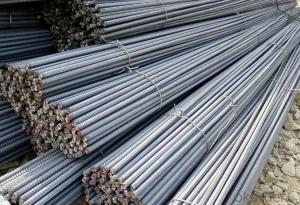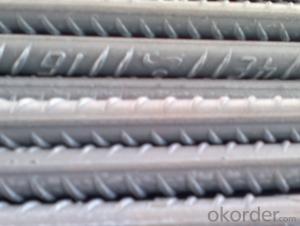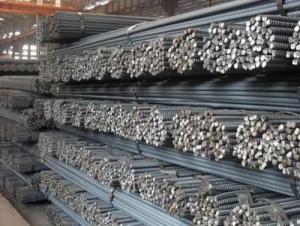Hot Rolled Steel Rebar
- Loading Port:
- China Main Port
- Payment Terms:
- TT or LC
- Min Order Qty:
- 25MT m.t.
- Supply Capability:
- 800000TONS/YEAR m.t./month
OKorder Service Pledge
OKorder Financial Service
You Might Also Like
Specifications of Hot Rolled Steel Rebar:
Standard | GB UK USA | HRB335 HRB400 HRB500 G460B, B500A, B500B,B500C GR40, GR60 | |
Diameter | 6mm,8mm,10mm,12mm,14mm,16mm,18mm,20mm, 22mm,25mm,28mm,32mm,36mm,40mm,50mm | ||
Length | 6M, 9M,12M or as required | ||
Price | Keep lower operating costs so as to offer competitive price for our clients | ||
Delivery Detail | within 45 days after received advanced payment or LC. | ||
Application | mainly used in construction industry to reinforce concrete structures and so on | ||
Invoicing | Actual or Theoretical Weight Basis as buyer’s request. | ||
Type | Hot rolled steel rebar | ||
Brand name | DRAGON | ||
Theoretical weight and section area of each diameter as below for your information:
Diameter(mm) | Section area (mm²) | Mass(kg/m) | Weight of 12m (kg) | Pcs/ton |
6 | 28.27 | 0.222 | 2.664 | 375.38 |
8 | 50.27 | 0.395 | 4.74 | 210.97 |
10 | 78.54 | 0.617 | 7.404 | 135.06 |
12 | 113.1 | 0.888 | 10.656 | 93.84 |
14 | 153.9 | 1.21 | 14.52 | 68.87 |
16 | 201.1 | 1.58 | 18.96 | 52.74 |
18 | 254.5 | 2.00 | 24 | 41.67 |
20 | 314.2 | 2.47 | 29.64 | 33.74 |
22 | 380.1 | 2.98 | 35.76 | 27.96 |
25 | 490.9 | 3.85 | 46.2 | 21.65 |
28 | 615.8 | 4.83 | 57.96 | 17.25 |
32 | 804.2 | 6.31 | 75.72 | 13.21 |
36 | 1018 | 7.99 | 98.88 | 10.43 |
40 | 1257 | 9.87 | 118.44 | 8.44 |
50 | 1964 | 15.42 | 185.04 | 5.40 |
The production process of Steel Rebar

1-Waling beam furnace 2-Roughing rolling group 3-Intermediate rolling train
4-Finishing rolling group 5-Water-cooling device 6-Walking beam cooler
7-Finishing equipment(including the cold scale shear,short feet collection system,
automatic counting device,bundling machine, collect bench)
Usage and Applications of Hot Rolled Steel Rebar:
Deformed bar is widely used in buildings, bridges, roads and other engineering construction. Big to highways, railways, bridges, culverts, tunnels, public facilities such as flood control, dam, small to housing construction, beam, column, wall and the foundation of the plate, deformed bar is an integral structure material. With the development of world economy and the vigorous development of infrastructure construction, real estate, the demand for deformed bar will be larger and larger..
Packaging & Delivery of Hot Rolled Steel Rebar:
Packaging Detail: products are packed in bundle and then shipped by container or bulk vessel, deformed bar is usually naked strapping delivery, when storing, please pay attention to moisture proof. The performance of rust will produce adverse effect.
Each bundle weight: 2-3MT, or as required
Payment terms: TT payment in advance or Irrevocable LC at sight.
Trade terms :FOB, CFR, CIF
Label:to be specified by customer, generally, each bundle has 1-2 labels
Steel Rebar in stock
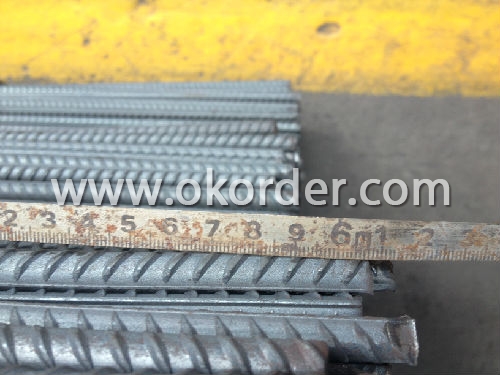
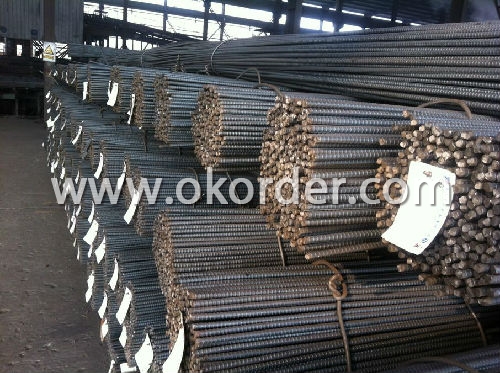
Note:
1. Our products are produced according to national standard (GB), if not, supply according to national standards (GB) or agreement as customer required.
2. Other Grade and Standard Deformed Steel Bar we can supply:
Grade: GR40/GR60, G460B/B500A/B500B/B500C,BST500S
Standard: ASTM, BS, DIN
The Minimum Order Quantity of these products is high, and need to be confirmed.
3. We can not only supply Deformed Steel Bar; if you need anything about building materials, please contact us for further information.
4. Please send us your detail specifications when inquire. We will reply to you as soon as possible. We sincerely hope we can establish a long stable business relationship.
- Q:How are steel rebars used in power plant construction?
- Steel rebars are used in power plant construction to reinforce concrete structures such as foundations, walls, and columns. These rebars provide added strength and durability, ensuring that the structures can withstand the heavy loads and extreme conditions present in power plants.
- Q:Can steel rebars be used in foundation structures?
- Yes, steel rebars can be used in foundation structures. Steel rebars are commonly used in reinforced concrete foundations to provide strength and structural integrity. They are used to reinforce the concrete and enhance its load-bearing capacity, making it suitable for supporting heavy structures and resisting forces like earthquakes and soil movement.
- Q:What is the impact of steel rebars on the overall carbon footprint of a building?
- Steel rebars have a significant impact on the overall carbon footprint of a building. The production of steel involves high carbon emissions, contributing to greenhouse gas emissions and climate change. Additionally, the extraction of raw materials and the transportation of steel rebars further increase carbon emissions. However, steel rebars provide structural strength and durability, reducing the need for future repairs or replacements. Therefore, while the use of steel rebars does contribute to the carbon footprint, proper construction practices and efficient use of materials can help mitigate their environmental impact.
- Q:Are steel rebars resistant to chemical damage?
- Yes, steel rebars are generally resistant to chemical damage.
- Q:Are steel rebars suitable for use in sports stadiums and arenas?
- Steel rebars are indeed suitable for use in sports stadiums and arenas. They are extensively utilized in construction due to their exceptional strength and durability properties. In settings such as sports stadiums and arenas, where there is a convergence of large crowds, heavy loads, and utmost concern for safety, steel rebars play a vital role in fortifying the structure. They possess the capacity to endure high tensile forces and prevent bending, making them an ideal choice for reinforcing concrete structures within stadiums and arenas. Moreover, steel rebars exhibit a high resistance to fire, which is of utmost importance in these sprawling public spaces. All in all, steel rebars are a dependable and well-established option for reinforcing sports stadiums and arenas, as they effectively provide the necessary support and meet safety requirements.
- Q:What is the role of steel rebars in minimizing cracking due to shrinkage?
- The role of steel rebars in minimizing cracking due to shrinkage is to provide reinforcement and strength to concrete structures. By placing steel rebars within the concrete, they act as a framework that helps distribute the tensile forces caused by shrinkage. This prevents the concrete from cracking and ensures the overall stability and durability of the structure.
- Q:What are the standard sizes for steel rebars?
- Steel rebars come in various standard sizes, which depend on both the country and industry standards. However, there are some commonly used sizes for steel rebars, such as #3, #4, #5, #6, #7, #8, #9, #10, #11, #14, and #18. These numbers correspond to the diameter of the rebar in inches. For instance, a #3 rebar has a diameter of 3/8 inch, while a #18 rebar has a diameter of 2 1/4 inches. It is worth noting that different countries may employ their own unique sizing systems. Therefore, it is always essential to refer to the local building codes and standards to obtain accurate information regarding steel rebar sizes.
- Q:What is the impact of steel rebars on the constructability of a project?
- Steel rebars have a significant impact on the constructability of a project. These reinforcement bars play a crucial role in strengthening and providing structural integrity to concrete structures. By incorporating steel rebars, the overall strength, durability, and resilience of a construction project are greatly improved. One of the key impacts of using steel rebars is the increased load-bearing capacity of the structure. Rebars are designed to withstand tension, which complements the concrete's ability to resist compression. This combination enhances the structural strength of the project, enabling it to withstand heavy loads and external forces, such as earthquakes or high winds. Moreover, steel rebars also enhance the ductility of the concrete structure. Ductility refers to the material's ability to deform without breaking. By adding rebars, the concrete becomes more flexible, allowing it to absorb energy and deform under stress before reaching its breaking point. This is particularly important in areas prone to seismic activities, as it helps prevent sudden and catastrophic failure of the structure. Another aspect of constructability impacted by steel rebars is the overall lifespan of the project. The corrosion resistance properties of rebars, especially when coated or galvanized, significantly extend the lifespan of the structure. This is particularly relevant in environments with high humidity, coastal areas, or regions with harsh weather conditions. By preventing corrosion and maintaining the integrity of the rebars, the entire project's longevity and durability are greatly enhanced. Additionally, steel rebars also facilitate the construction process itself. Their availability in various lengths, shapes, and sizes allows for flexible and efficient design and construction. Contractors can easily cut, bend, and shape rebars to fit specific project requirements, reducing construction time and costs. Moreover, rebars can be prefabricated off-site, minimizing on-site labor and simplifying the construction process. In conclusion, the impact of steel rebars on the constructability of a project is highly significant. They improve the overall strength, load-bearing capacity, ductility, and lifespan of the structure. Additionally, the flexibility and ease of use of steel rebars contribute to efficient construction practices. Therefore, incorporating steel rebars into a project is essential for ensuring its structural integrity and long-term success.
- Q:How do steel rebars affect the overall sustainability of a structure?
- Steel rebars have a significant impact on the overall sustainability of a structure. Firstly, the use of steel rebars contributes to the strength and durability of the building, ensuring its longevity and reducing the need for frequent repairs or replacements. This leads to a reduction in the consumption of raw materials and energy required for construction, making the structure more sustainable. Additionally, steel rebars help improve the structural integrity of a building, making it more resistant to natural disasters such as earthquakes and hurricanes. By enhancing the safety and resilience of the structure, steel rebars minimize the potential for damage and loss, which in turn reduces the environmental impact associated with reconstruction and waste generation. Furthermore, steel rebars can be recycled at the end of a building's life cycle. Steel is highly recyclable, and reusing steel rebars significantly reduces the demand for virgin steel production and the associated carbon emissions. Recycling steel also conserves natural resources and reduces landfill waste, making it a more sustainable option than using other materials. Moreover, the use of steel rebars in structures allows for greater design flexibility and adaptability. This means that buildings can be easily modified or repurposed, reducing the need for demolition and reconstruction. The ability to repurpose existing structures reduces waste and energy consumption, contributing to the overall sustainability of the built environment. In summary, steel rebars positively impact the overall sustainability of a structure through their durability, strength, and recyclability. By enhancing the longevity, safety, and adaptability of a building, steel rebars reduce the environmental impact associated with construction, maintenance, and demolition.
- Q:How do steel rebars affect the overall maintenance requirements of concrete structures?
- Steel rebars play a crucial role in the overall maintenance requirements of concrete structures. These reinforcing bars are used to enhance the strength and durability of concrete by providing tensile strength and preventing cracks. By adding steel rebars to concrete, the structure becomes better equipped to resist the forces that it may encounter during its lifespan. One of the primary ways that steel rebars affect maintenance requirements is by reducing the likelihood of cracks in concrete structures. Concrete on its own is strong in compression but weak in tension. When subjected to tensile forces, such as loads or temperature fluctuations, concrete tends to crack. However, by incorporating steel rebars within the concrete, these cracks are minimized or prevented altogether. This is because the steel rebars absorb the tensile forces, allowing the concrete to remain intact and intact structures require less maintenance. Furthermore, steel rebars also increase the overall strength of concrete structures, making them more resistant to external forces. This added strength reduces the chances of structural failure, thereby decreasing the maintenance requirements in terms of repairs or replacements. Additionally, the use of steel rebars can extend the lifespan of concrete structures, as they provide the necessary reinforcement to withstand the test of time. However, it is essential to note that steel rebars can also be susceptible to corrosion over time, which can impact the maintenance requirements of concrete structures. When steel rebars corrode, they expand, causing cracks and spalling in the concrete. This corrosion can be accelerated by various factors such as exposure to moisture, chloride ions, or carbonation. Therefore, regular inspections and maintenance measures, such as protective coatings or cathodic protection, must be implemented to prevent or manage the corrosion of steel rebars. In conclusion, steel rebars have a significant impact on the overall maintenance requirements of concrete structures. They enhance the strength, durability, and resistance of concrete, reducing the occurrence of cracks and structural failures. However, proper maintenance and protection against corrosion are necessary to ensure the continued effectiveness of steel rebars, ultimately contributing to the longevity and low maintenance needs of concrete structures.
1. Manufacturer Overview |
|
|---|---|
| Location | Hebei, China |
| Year Established | 2009 |
| Annual Output Value | Above US$ 500 Million |
| Main Markets | Southeast Asia; East Asia; Middle east |
| Company Certifications | ISO 9001:2008 |
2. Manufacturer Certificates |
|
|---|---|
| a) Certification Name | |
| Range | |
| Reference | |
| Validity Period | |
3. Manufacturer Capability |
|
|---|---|
| a)Trade Capacity | |
| Nearest Port | Tianjin; |
| Export Percentage | 40%-60% |
| No.of Employees in Trade Department | 21-60 People |
| Language Spoken: | English; Chinese |
| b)Factory Information | |
| Factory Size: | Above 850,000 square meters |
| No. of Production Lines | Above 5 |
| Contract Manufacturing | OEM service offered |
| Product Price Range | high; average |
Send your message to us
Hot Rolled Steel Rebar
- Loading Port:
- China Main Port
- Payment Terms:
- TT or LC
- Min Order Qty:
- 25MT m.t.
- Supply Capability:
- 800000TONS/YEAR m.t./month
OKorder Service Pledge
OKorder Financial Service
Similar products
New products
Hot products
Hot Searches
Related keywords








